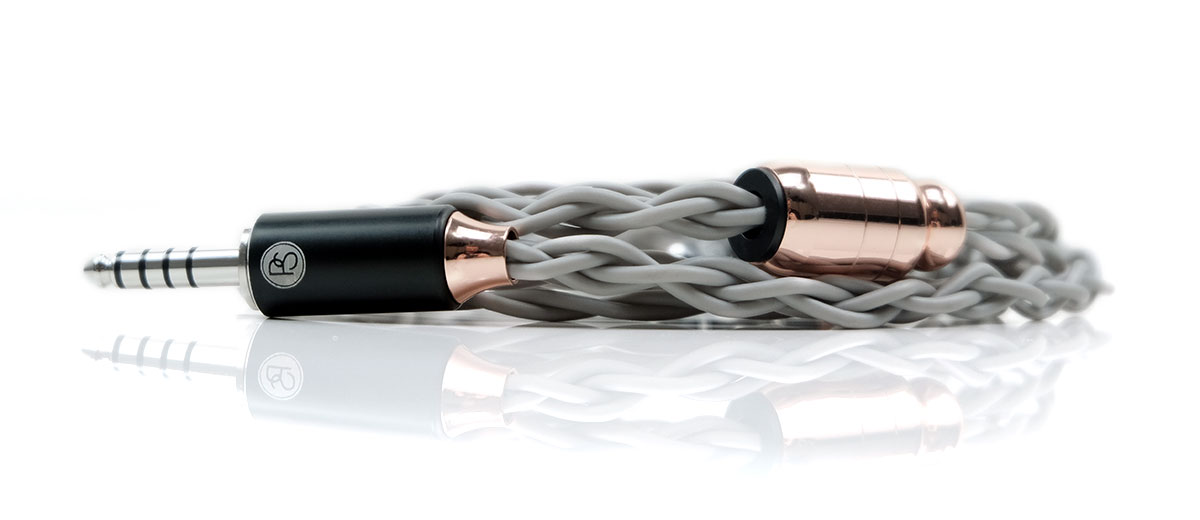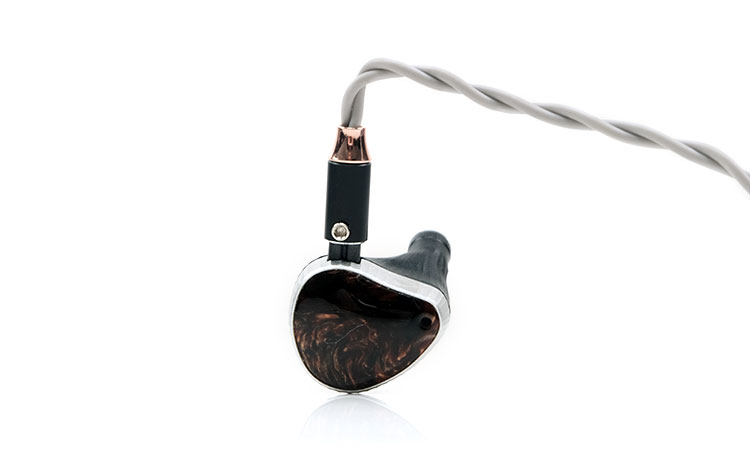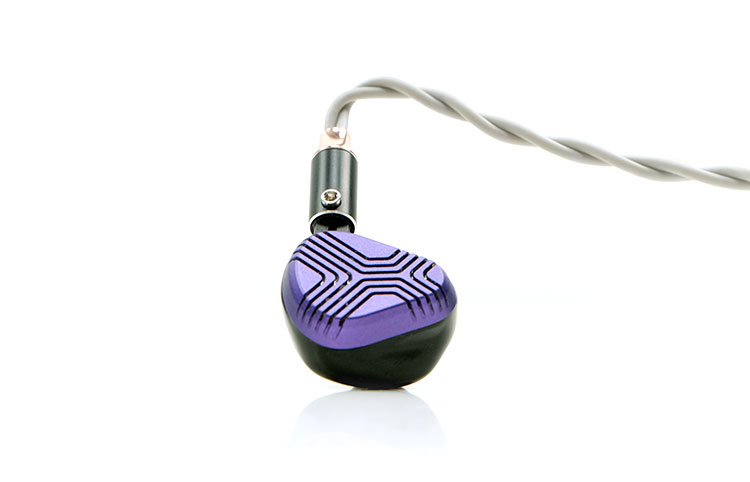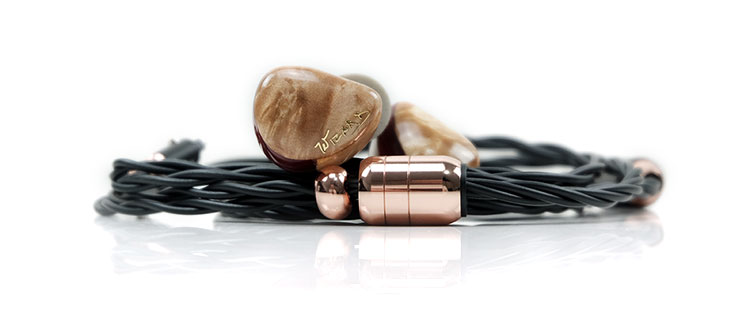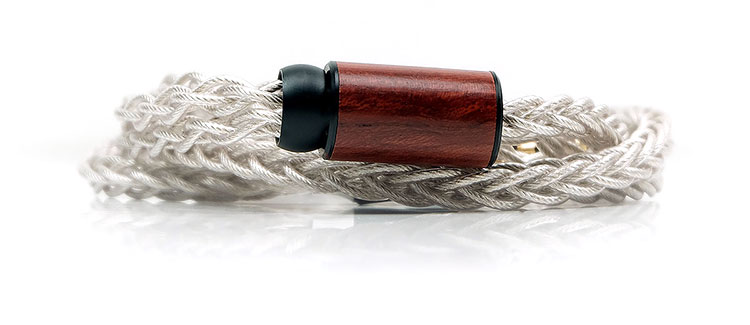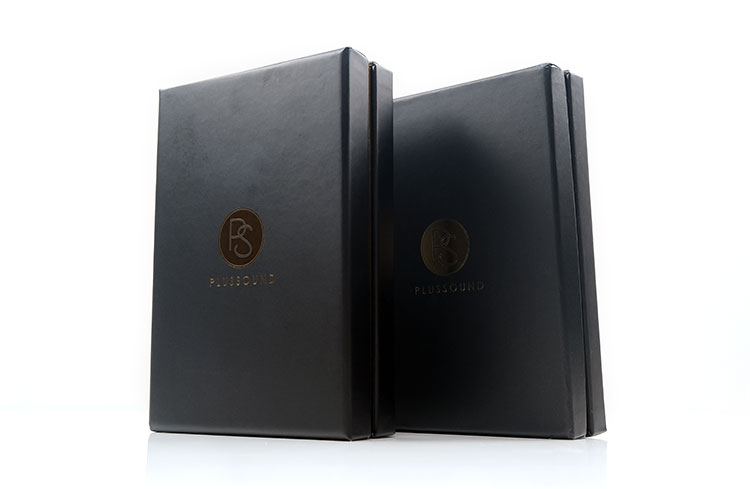Performance Impressions
Summary
The Silver+ is one of the purest-sounding pairings I have heard from a PLUSSOUND cable since the launch of the Tri-Silver series a few years back.
Actually, if anything, the Silver+ is even more neutral-sounding compared to the more excitable Tri-Silver and probably the company’s most linear and reference-like creation that I have reviewed to date.
Despite its neutrality and overall clean tone, it does not play up to the ‘silver is bright’ meme. It is actually quite controlled from top to bottom with nothing edgy coming through with our paired monitors. Surprisingly, it was the Tri-Silver that offered a little more exuberance on the top end whereas the Silver+ stayed quite refined and clear.
I will go into this in a bit more detail in the synergy section but overall, this is an excellent cable for pairing with electrostatic driver-implemented IEMs.
You get a lot of clarity and micro-detail shining through but very little in the way of grain or sharpness. Monitors such as Noble Audio’s Sultan and the VE EXT’s top-end electrostatic driver arrays sounded very pure and pristine which in turn keeps the mids in check for any unnatural sibilance or percussion splashiness.
On the flip side, the neutrality does mean it will not add any additional weight or warmth on the low end quite like the Copper+ and the soon-to-be-reviewed Hybrid+.
This is not a shallow sound, however. There is no reduction in a monitor’s ability to reach deep but the presence is still relatively neutral sounding and in some instances, there is a slight emphasis on the mid-bass punch of a monitor but less so on sub-bass rumble.
Timbre
Linear yes, neutral yes, but not cold, definitely not a cold or sharp-sounding silver cable. When paired with our 3 test monitors the sound was very accurate and revealing but just the tiniest hint of warmth creeping into the mids and highs kept the treble from coloring the mids with too much ‘crispness’.
Everything is contextual with cable pairings, so the timbre is not as warm and earthy as the Copper+ and not quite as sweet as the Hybrid+ through the mids. However, of the 3 cables, the Silver+ offered the most clarity without coming across as sterile or edgy. Accuracy would be a very good word here in all honesty.
Despite some neutral imaging, the Silver+ is not relaxed or unengaging sounding through the mids. I suspect this is where the famed silver high-frequency reproduction makes itself known in terms of just how vivid and detailed our monitors sounded when paired with the Silver+.
There are a lot of nuanced upper mids and treble notes shining through with a lot more clarity on the Sultan, for example, compared to the Copper+. Just a hint of more treble coloration and electrostatic presence that gives these notes a little more definition and sparkle on the Sultan.
Staging (& Dynamic Range)
The Silver+ calls it down the line. It does not emphasize the lows, mids, or highs of our tested monitors. In fact, how you perceive that in terms of staging and imaging is largely going to be driven by the cable you had on before you slap on the Silver+.
That means is it not as forward in the bass or vocal imaging as the Hybrid+ or the Copper+ but it will sound more mid-centric and revealing and airier in the highs compared to those same said two cables. It is also less forward and slightly smoother sounding compared to the likes of the Tri-Silver X8 for upper-mids and treble presence from the EXT and the U18s.
The dynamic range from the Silver+ pairings we used is excellent and very competitive with larger wire counts such as the Tri-Silver X8.
That larger gauge really did narrow the gap in terms of resistance performance and relative volume matching on our sources. The odd time I felt the Tri-Silver had a very slight advantage in terms of the dynamics of its bass attack with our hybrid monitors but it was very subtle.
Synergy
In some ways, Silver+ is the polar opposite of Copper+ for pairing. In my previous review, I remarked that the Copper+ had a soothing effect on monitors such as the Noble Audio Khan’s piezoelectric driver and indeed electrostatic drivers, in general, have a more liquid tone to them.
The Silver+ teases out a lot more high-frequency presence and energy, which in turn, gives a more prominent platform for hybrid electrostatic drivers to be heard. Now, that might seem to translate to ‘bright’ but it really does not but it is more energetic compared to the Copper+.
What I was finding instead was a lot more clarity and extension but without any grainy harshness. Monitors such as the Noble Audio Sultan and the VE EXT’s electrostatic drivers sounded lively, clean, and pure in tone with the Silver+ but not overly forward or edgy sounding.
Yes, just a slightly thinner amount of body but electrostatic and BA tweeters are never really going to be thick and lush drivers, to begin with. What is important is the ability to hear them at work without them unbalancing the sound and the Silver+ does that very well.
On the flip side, the Silver+ pairing with the same monitors isn’t going to add any additional weight or warmth to the low end. I would recommend the Hybrid+ or the Copper+ if you want to achieve that kind of sound signature. Monitors still sound punchy but the performance is more linear and neutral from the monitors such as the EXT with a focus instead on clarity.
Select Comparisons
All comparisons were completed using a Vision Ears EXT, 64 Audio’s U18s, and a Noble Audio Sultan.
PLUSSOUND Copper+
$999.99
This is the first of the ‘plus’ series cables from PLUSSOUND and one we featured in the 3rd quarter of 2021. You can find our full review here.
Technical
The technical specifications of both of these cables are virtually the same save for the choice of wire and the external finishing.
That means both are using a Litz build with an inner conductor and an outer shield sharing a geometric axis with the Silver+ using a single high purity UP-OCC pure silver 4-wire with a higher 24AWG and the Copper+ using UP-OCC 24AWG copper 4-wire.
The core of both cables is built using a single twist Litz configuration of each wire element with the outer layer also UP-OCC with 5-strand bundles in a Litz configuration. Both the single twist and 5 strand twists of each cable are enameled at the individual strand level to prevent the dreaded green oxidization effect.
Both cables use PS Insulation between the wire bundles to isolate them and PS Shielding just under the outer PS Insulation to protect the cable from EMI and other potential electrical interferences.
Design
The most striking aesthetical difference between these two cables is probably the jacket finishing. The Copper+ sample we have here uses a matte black twisted finish whereas the Silver+ sample uses a matt grey braided design.
That means the Copper+ form factor is a little thinner compared to the beefier Silver+ but in turn, I actually found the Silver+ braiding to be a little more flexible despite it having a slightly thicker strand built on the inside, (for silver stability).
Because both are a little stiffer than the older PVC constructions, handling is not quite as good and microphonics is a shade higher below the splitter. However, both are quite disciplined in their handling with very little in the way of memory retention when unfolded.
Finishing options are almost exactly the same and you do have the ability to mix and match barrels, jacks, and connectors at the PLUSSOUND website checkout.
Personally, the rose gold and black jack/connector barrels look very stylish on the Copper+ but slightly less so on the Silver+. I would recommend going for the chrome or silver finishing for the stamped metal accents and the splitter/cinch to give it the perfect look.
Performance
The Copper+ is more of an emotional soul with a stronger lean on the even harmonic side with our tested monitors. Whereas the Silver+ plays it cooler, cleaner, and more reference-like in its synergy.
With the Copper+ you get more warmth, smoothness, and bass volume, with perhaps some added sub-bass presence to bring your ear a little further down. Vocals are euphonic, timbrally richer, and slightly more intimate in their imaging.
The Silver+ imaging is more neutral, the timbre has more of an odd-harmonic influence and the bass is punchy with less sub-bass perceived weight but tighter and better defined. One thing I really noted with the Silver+ is how it teases out more high-frequency information or perceived treble resolution with electrostatic IEMs.
For example, the VE EXT sounds voluminous and physical with the Copper+ but your attention is firmly fixed on vocals, mids, and bass. The Silver+ teases out a lot more of the electrostatic quality and presence. In doing so the EXT sounds more open, more delicate, and pure for the highs bringing your ear further north for staging.
I would say the Copper+ delivers a heftier low-end and more power paired with the Sultan and the EXT. However, the Silver+ improves on the perceived midrange detail and airiness from the highs of both monitors.
PLUSSOUND Hybrid+
$1299.99
We will have a full review of the Hybrid+ shortly so consider these sorts of initial impressions but well worth a comparison at this stage, nonetheless.
Technical
The Hybrid+ follows the exact same geometry or wire build format as both the Silver+ and the Copper+ cables. That means a Litz build with an inner conductor and an outer shield sharing a geometric axis, PS insulation isolating the core, and PS Shielding to deal with EMI and other related factors that could cause interference in the signal.
The key technical difference between both cables internal is in the wire selection with a hybrid of both UP-OCC copper and UP-OCC silver for the Hybrid+ rather than just UP-OCC silver for the Silver+.
The blending of the different Hybrid+ wires is not in a mixed alloy, nor is it, for example, inner silver, or outer copper. This is a 4-wire configuration with 2 wires for high-purity UP-OCC silver and 2 wires for high-purity UP-OCC copper.
You can see this technical difference reflected clearly in the outer design with the braiding and blending of both the Silver+ matt grey jacket and the Copper+ matt black jacket into one cable.
Design
A big difference here visually as you would expect from reading the above with the two-tone matte grey and black of the Hybrid+ compared to the wholly matt grey experience of the Silver+
However, the handling and tensile feedback from both cables are almost the same. I say almost because if you remember at the start of this review I mentioned that the strands in the Silver+ are slightly thicker due to the more delicate nature of silver strands compared to copper.
That means that the 2-wire side of the Hybrid+, complete with the jacket, is slightly chunkier than the matt black copper 2-wires. Not noticeably so and only when you study it up close. I find that difference gives the Hybrid+ a very slight change in its handling and overall feel giving it a bit more retention when compressing in one hand.
Otherwise, both cables have the same properties including low microphonics and memory retention but are slightly stiffer in their handling compared to the classic PLUSSOUND transparent PVC cable builds.
Options for the Hybrid+ finishing such as barrels, plugs, and connectors are the exact same as the Silver+. I do like the supplied Hybrid+ sample finished color scheme with the black and silver barrels and connectors. Something similar to the matte grey of the Silver+ should give it an on-par visual.
Performance
The Hybrid+ is not as warm or soft sounding as the Copper+ when paired with the Sultan and the EXT but neither does it exact such a reference tone as the Silver+. It lies somewhere in between as you would naturally expect with a stronger sub-bass presence, a slightly smoother more flowing midrange, and a treble that sits back but is still quite lively.
On both the EXT and the Sultan the Silver+ bass is comparatively neutral but still punchy though with less body coming into the lower mids. The Hybrid+ delivers a low-end with a bit more aplomb and gusto and sounds excellent with bass-centric music.
The Silver+ has a stronger midrange performance for me but it is not quite as evenly balanced as the Hybrid+ for timbre. Not a negative but rather it is just the more accurate, precise, and articulate of the two cables through the mids and for the higher frequency spatial cues.
Again, the Silver+ loves those electrostatic drivers so you get some pristine clarity in the highs whereas the Hybrid+ is more liquid and natural in tone. The Hybrid+ is not as laid back as the Copper+ but rather than a precise clean tone or warmth through the mids, I would describe it more as sweet-sounding with a light smattering of treble overtones.
PLUSSOUND Tri-Silver X8
$1599.99 (X8 Series)
Although the Tri-Silver X8 is an 8-wire as opposed to 4, its smaller gauge and use of silver make this flagship cable a worth comparison. You can read our previous review of the Tri-Silver here. Note, you can get the Tri-Silver in the Exo range similar to the Silver+.
Technical
Some big differences both inside and out and in a way the Tri-Silver represents PLUSSOUND’s previous generation of creations though by no means a lesser cable as it is still one of their flagship creations.
The Tri-Silver X8 is an 8-wire 26AWG creation as opposed to a 4-wire 24AWG inside the Silver+. Normally, I see this as mutual cancellation in terms of dynamic range and resistance. You get more wires with the Tri-Silver but a larger gauge with the Silver+.
The mix of elements is more exotic inside the Tri-Silver whereas the geometry inside the Silver+ is perhaps the more complex of the two cables. The Tri-Silver is a blend of pure silver, gold-plated silver, and palladium-plated silver whereas the Silver+ is a single element of high-purity UP-OCC silver.
The geometry inside the Tri-silver is a little simpler using a classic Type 6 Litz build which features bundles of type-4 wire twisted around a fiber core whereas Type 1 and 2 wiring has no individual cores. There is no inner or outer core structure though the Silver+ does use a Litz-type bundle build for both cores.
Design
The previous style ethos meets the new style ethos and both have pros and cons. One thing that is relatively consistent is the finishing on both cables including the barrels, jacks, and connectors.
You can pick which ones exactly fit your needs but for the Tri-Silver sample, we have the premium Rosewood finished barrel which shaves a fair bit of weight from the cable overall. One nuanced change that might just be a running product tweak is the jack barrel length which is slightly short or smaller on the Silver+.
The Tri-silver does use the classic translucent PVC jacket combined with a very tight yet flexible braiding technique. It is still the thicker and heavier of the two cables with that 8-wire build but it is not quite as stiff as the Silver+’s new braided matt grey jacket.
The handling does then vary with the less flexible Silver+ on the one side versus the heavier softer Tri-Silver on the other side. You will feel the added weight around your ear of the Tri-Silver which might not suit glasses users but in return, it’s a little less microphonics. The Silver+ has similar memory retention levels but is much lighter around the ear in comparison.
Performance
First, there is very little evidence of a substantial dynamic range gap between these two cables despite one being a 4-wire and the other being an 8-wire.
That larger gauge of the Silver+ competes very well indeed with the Tri-Silver X8. Our test DAP, the LP P6 Pro required no volume adjustments either with our test monitor for this comparison, the 64 Audio U18s.
Where they do differ is in the quality of the mids and highs and the timbral coloration throughout. Neither are warm and fuzzy cables with more emphasis on clarity and precision.
However, the Silver+ seems much more linear to my ear from top to bottom. Whereas the Tri-Silver X8 does have a slightly feistier treble presence and is a little further forward sounding also in that region.
That changes the timbre of both with the Tri-Silver showing a little more uptake in odd-harmonics, with magnified upper-mids and treble presence and a bit brighter for percussion and sibilance.
The Silver+ is slightly the more liquid of the two on the U18s for its attack and not quite as hard-edged. Of the two, it is the more gentile sounding through the mids and treble and probably the more balanced and reference-tilted as a result.
The bass response on both is snappy and punchy with little in the way of euphonic warmth or bloom with the U18s and the Sultan. However, something about the Tri-Silver bass felt a little deeper maybe, or more physical with the tested hybrid monitors. That could well be a dynamic range difference revealing itself there or slightly more underpinning sub-bass.
Our Verdict
To me, the PLUSSOUND Silver+ is exactly how a good quality silver wire should sound like. Nothing is over-emphasized, with an excellent focus on detail and clarity and a specific panache for hybrid monitors using electrostatic drivers. Pure, controlled, and articulate without ever sounding unnatural or edgy.
The new design materials around the wiring are I believe a necessity for the enhanced shield and coaxial design but it is still not quite as pliable as the classic transparent PVC designs. Here I think is its slight weakness as an aftermarket cable for handling.
The braiding does improve things in terms of flexibility though over the twisted Copper+ so that is a step in the right direction. Also, the finishing quality is as good as ever for barrels and connectors. The rest is down to you in terms of mixing and matching colors and termination types.
Overall, the most reference-like high-end cables that I have reviewed to date from PLUSSOUND.
PLUSSOUND Silver+ Specifications
- Wire: UP-OCC Silver
- Gauge: 24AWG
- Core Count: 4 (comes in 6 and 8 also)
- Geometry: 2 in 1 Coaxial-Type Litz
- PS Insulation (new proprietary matte grey)
- PS Shielding – semi-conductive + ground layer
- Length: 1.2m (longer upon request)

